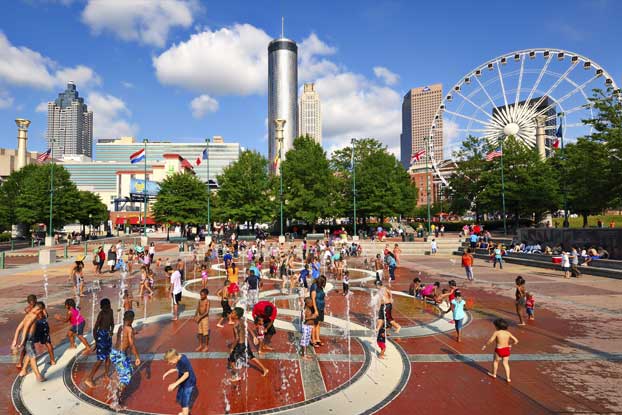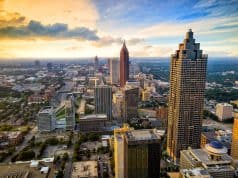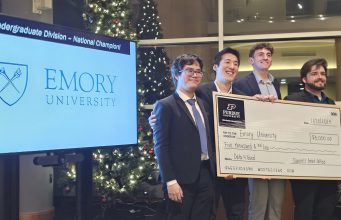
Leaving even a short-term positive legacy has proven difficult in recent decades for several Olympic venues around the world. But two decades removed from the 1996 Atlanta Olympics, most of those venues have survived.
Many have thrived, two Goizueta Business School instructors said
Some of the keys, which should serve as a model for future sites, are to avoid massive amounts of debt that cripple cities and countries in their wake, and develop cooperation with the private sector that will use the venues in some capacity for decades to come.
“The story was that these things got built in a way that anticipated their having a long and useful life,” said Ray Hill, a Senior Lecturer in Finance, when asked about Atlanta’s remaining structures. “… That’s the model the world ought to be adopting: let the people who are going to benefit from it — the private sector entities that are going to reap the rewards — let them finance these things and let’s not have it be this gargantuan expenditure of public money.”
Centennial Olympic Park and Turner Field, known at the time as Centennial Olympic Stadium, have served as the home since for the Atlanta Braves. But recently, following the Braves’ announced move to Cobb County, Georgia State University and City of Atlanta officials announced a deal to purchase the 70-acre plot.
That deal is expected to close by the end of the year for $30 million.
The Georgia State development plan includes student housing, apartments, single-family homes, classroom space, a grocery store, a football stadium and a Panthers baseball field, the Atlanta Journal-Constitution reported.
Roy Black, a Goizueta Professor in the Practice of Finance, said the Turner Field site would join the trend — and benefit from — improving residential areas by making them walkable, and having a mix of residential, retail and office space.
“That’s kind of an amazing legacy and metamorphosis, to have that one site go through three different athletic uses, and now be brand-new for the facility that Georgia State will use for a long, long time,” said Black, who noted the makeover of the site would preserve the Hank Aaron home run wall as part of the baseball stadium. “The continuity is great, a wonderful story, and part of the legacy of the Olympics.”
While Turner Field will be converted, the Georgia Dome is set for demolition 25 years since it opened. The Atlanta Falcons will move into the $1.4 billion Mercedes-Benz Stadium in 2017. The Dome during the Olympics was known for hosting the men’s basketball gold medal game and the Magnificent Seven victory for America’s women’s gymnastics.
Other remaining venues include Centennial Olympic Park, which is home to the Georgia Aquarium, World of Coca-Cola, College Football Hall of Fame and National Center for Civil and Human Rights. The Georgia Tech Aquatic Center — site of Olympic swimming — hosted the NCAA swimming championships and a pre-Olympic camp for the U.S. team before this year’s games in Rio.
“The real story is the far-sightedness and wisdom of having private money build these things 20 years ago,” Hill said.
One blemish is the Stone Mountain Tennis Center, which sits idle and in disrepair. Herndon Stadium, which hosted field hockey in 1996, sits abandoned.
But Sanford Stadium at the University of Georgia, which hosted soccer, and Alexander Memorial Coliseum at Georgia Tech, which hosted boxing, were each recycled for future use. They remain in use today.
“Overall, I think it has been a very successful plan, and definitely one of the more successful Olympics in terms of not wasting money, and not wasting taxpayer money,” Black said.
The games also brought fiber optic cable and infrastructure improvements to downtown, noted Black, who called the Atlanta Olympic planning “fantastic.”
“I think that legacy is still with us,” he said. “I also think we’ve done a much better job of planning in advance and recycling the venues than a lot of cities have.”
While Montreal took decades to pay off Olympic debt, Hill noted said Athens, Greece didn’t have money to maintain its Olympic facilities.
Nicknamed the “Big Owe,” the $1.5 billion debt from Quebec’s Olympic Stadium in Montreal (1976 Summer Games) wasn’t paid off until 2006, according to CBC News.
“It was a major financial hit for the city of Montreal, and we didn’t take the tax hit in Atlanta,” Black said. “It was really very well planned. The public-private partnership here really worked. Probably also indicative, I think, is the way that Atlanta has developed its real estate and its infrastructure, which has been a lot of very successful cooperation between private sector and government entities.”









